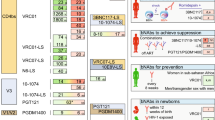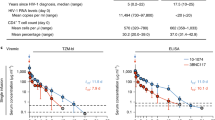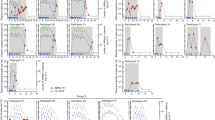Abstract
Even after more than 30 years since its discovery, there is no cure for HIV-1 infection. Combination antiretroviral therapy (cART) is currently the only HIV-1 infection management option in clinics. Despite its success in suppressing viral replication and converting HIV-1 from a lethal infection to a chronic and manageable disease, cART treatment is life long and long-term use can result in major drawbacks such as high cost, multiple side effects, and an increase in the development of multidrug-resistant escape mutants. Recently, antibody-based anti-HIV-1 treatment has emerged as a potential alternative therapeutic modality for HIV-1 treatment and cure strategies. These antibody-based anti-HIV-1 treatments comprising either receptor-targeting antibodies or broad neutralizing antibodies (bNAbs) are currently being developed and evaluated in clinical trials. These antibodies have demonstrated potent antiviral effects against multiple strains of HIV-1, and shown promise for prevention, maintenance, and prolonged remission of HIV-1 infection. This review gives an update on the current status of these antibody-based treatments for HIV-1, discusses their mechanism of action and the challenges in developing them, providing insight for their development as novel clinical therapies against HIV-1 infection.

Similar content being viewed by others
References
Mocroft A, Vella S, Benfield TL, et al. Changing patterns of mortality across Europe in patients infected with HIV-1. EuroSIDA Study Group. Lancet. 1998;352(9142):1725–30.
Trovato M, D’Apice L, Prisco A, et al. HIV vaccination: a roadmap among advancements and concerns. Int J Mol Sci. 2018;19(4):E1241. https://doi.org/10.3390/ijms19041241.
Awi NJ, Teow SY. Antibody-mediated therapy against HIV/AIDS: where are we standing now? J Pathog. 2018;2018:8724549.
Oguntibeju OO. Quality of life of people living with HIV and AIDS and antiretroviral therapy. HIV AIDS (Auckl). 2012;4:117–24.
Gulick RM, Mellors JW, Havlir D, et al. Treatment with indinavir, zidovudine, and lamivudine in adults with human immunodeficiency virus infection and prior antiretroviral therapy. N Engl J Med. 1997;337(11):734–9.
Hammer SM, Squires KE, Hughes MD, et al. A controlled trial of two nucleoside analogues plus indinavir in persons with human immunodeficiency virus infection and CD4 cell counts of 200 per cubic millimeter or less. AIDS Clinical Trials Group 320 Study Team. N Engl J Med. 1997;337(11):725–33.
Sengupta S, Siliciano RF. Targeting the latent reservoir for HIV-1. Immunity. 2018;48(5):872–95.
Chun TW, Davey RT Jr, Engel D, et al. Re-emergence of HIV after stopping therapy. Nature. 1999;401(6756):874–5.
Kaufmann GR, Khanna N, Weber R, et al. Long-term virological response to multiple sequential regimens of highly active antiretroviral therapy for HIV infection. Antivir Ther. 2004;9(2):263–74.
Larder BA, Darby G, Richman DD. HIV with reduced sensitivity to zidovudine (AZT) isolated during prolonged therapy. Science. 1989;243(4899):1731–4.
Smith LK, Kuhn TB, Chen J, et al. HIV associated neurodegenerative disorders: a new perspective on the role of lipid rafts in Gp120-mediated neurotoxicity. Curr HIV Res. 2018;16(4):258–69.
Chen YF, Dugas TR. Endothelial mitochondrial senescence accelerates cardiovascular disease in antiretroviral-receiving HIV patients. Toxicol Lett. 2019;317:13–23.
Yuan NY, Kaul M. Beneficial and adverse effects of cART affect neurocognitive function in HIV-1 infection: balancing viral suppression against neuronal stress and injury. J Neuroimmune Pharmacol. 2019. https://doi.org/10.1007/s11481-019-09868-9.
Demir OM, Candilio L, Fuster D, et al. Cardiovascular disease burden among human immunodeficiency virus-infected individuals. Int J Cardiol. 2018;265:195–203.
Margolis DM, Garcia JV, Hazuda DJ, et al. Latency reversal and viral clearance to cure HIV-1. Science. 2016;353(6297):aaf6517.
UNAIDS Data 2019. 2019. https://www.unaids.org/sites/default/files/media_asset/2019-UNAIDS-data_en.pdf. Accessed 30 Jan 2020.
Caskey M, Klein F, Nussenzweig MC. Broadly neutralizing anti-HIV-1 monoclonal antibodies in the clinic. Nat Med. 2019;25(4):547–53.
Gama L, Koup RA. New-generation high-potency and designer antibodies: role in HIV-1 treatment. Annu Rev Med. 2018;69:409–19.
Parsons MS, Chung AW, Kent SJ. Importance of Fc-mediated functions of anti-HIV-1 broadly neutralizing antibodies. Retrovirology. 2018;15(1):58.
Alsaab HO, Sau S, Alzhrani R, et al. PD-1 and PD-L1 checkpoint signaling inhibition for cancer immunotherapy: mechanism, combinations, and clinical outcome. Front Pharmacol. 2017;8:561.
Scott AM, Wolchok JD, Old LJ. Antibody therapy of cancer. Nat Rev Cancer. 2012;12(4):278–87.
Salazar G, Zhang N, Fu TM, et al. Antibody therapies for the prevention and treatment of viral infections. NPJ Vaccines. 2017;2:19.
Henrich TJ, Kuritzkes DR. HIV-1 entry inhibitors: recent development and clinical use. Curr Opin Virol. 2013;3(1):51–7.
Thompson MA. The return of PRO 140, a CCR5-directed mAb. Curr Opin HIV AIDS. 2018;13(4):346–53.
Beccari MV, Mogle BT, Sidman EF, et al. Ibalizumab, a novel monoclonal antibody for the management of multidrug-resistant HIV-1 infection. Antimicrob Agents Chemother. 2019;63(6):e00110-19. https://doi.org/10.1128/AAC.00110-19.
Wang CY, Wong WW, Tsai HC, et al. Effect of anti-CD4 antibody UB-421 on HIV-1 rebound after treatment interruption. N Engl J Med. 2019;380(16):1535–45.
Trogarzo (ibalizumab-uiyk): pipeline status. 2019. http://www.taimedbiologics.com/pipeline/33. Accessed 30 Jan 2020.
Emu B, Fessel J, Schrader S, et al. Phase 3 study of ibalizumab for multidrug-resistant HIV-1. N Engl J Med. 2018;379(7):645–54.
Song R, Franco D, Kao CY, et al. Epitope mapping of ibalizumab, a humanized anti-CD4 monoclonal antibody with anti-HIV-1 activity in infected patients. J Virol. 2010;84(14):6935–42.
Kuritzkes DR, Jacobson J, Powderly WG, et al. Antiretroviral activity of the anti-CD4 monoclonal antibody TNX-355 in patients infected with HIV type 1. J Infect Dis. 2004;189(2):286–91.
Jacobson JM, Kuritzkes DR, Godofsky E, et al. Safety, pharmacokinetics, and antiretroviral activity of multiple doses of ibalizumab (formerly TNX-355), an anti-CD4 monoclonal antibody, in human immunodeficiency virus type 1-infected adults. Antimicrob Agents Chemother. 2009;53(2):450–7.
Norris D, Morales J, Godofsky E, Garcia F, Hardwicke R, Lewis S. TNX-355, in combination with optimized background regimen (OBR), achieves statistically significant viral load reduction and CD4 cell count increase when compared with OBR alone in phase 2 study at 48 weeks in AIDS Toronto; 2006. Oral abstract session: Abstract no. THLB0218.
NCT00784147: dose-response study of ibalizumab (monoclonal antibody) plus optimized background regimen in patients with HIV-1. 1/30/2020]. https://ClinicalTrials.gov/show/NCT00784147. Accessed 30 Jan 2020.
NCT02475629: ibalizumab plus optimized background regimen in patient with multi-drug resistant HIV. https://ClinicalTrials.gov/show/NCT02475629. Accessed 30 Jan 2020.
Wang CY, Sawyer LS, Murthy KK, et al. Postexposure immunoprophylaxis of primary isolates by an antibody to HIV receptor complex. Proc Natl Acad Sci USA. 1999;96(18):10367–72.
NCT01668043: study to evaluate safety and efficacy of UB-421 antibody in HIV-1 infected adults. https://ClinicalTrials.gov/show/NCT01668043. Accessed 30 Jan 2020.
Olson WC, Rabut GE, Nagashima KA, et al. Differential inhibition of human immunodeficiency virus type 1 fusion, gp120 binding, and CC-chemokine activity by monoclonal antibodies to CCR5. J Virol. 1999;73(5):4145–55.
Trkola A, Ketas TJ, Nagashima KA, et al. Potent, broad-spectrum inhibition of human immunodeficiency virus type 1 by the CCR5 monoclonal antibody PRO 140. J Virol. 2001;75(2):579–88.
Jacobson JM, Thompson MA, Lalezari JP, et al. Anti-HIV-1 activity of weekly or biweekly treatment with subcutaneous PRO 140, a CCR5 monoclonal antibody. J Infect Dis. 2010;201(10):1481–7.
NCT02355184: an extension of protocol PRO 140_CD01 TS study. https://ClinicalTrials.gov/show/NCT02355184. Accessed 30 Jan 2020.
Cavacini LA, Samore MH, Gambertoglio J, et al. Phase I study of a human monoclonal antibody directed against the CD4-binding site of HIV type 1 glycoprotein 120. AIDS Res Hum Retrovir. 1998;14(7):545–50.
Dezube BJ, Doweiko JP, Proper JA, et al. Monoclonal antibody hNM01 in HIV-infected patients: a phase I study. J Clin Virol. 2004;31(Suppl 1):S45–7.
Hinkula J, Bratt G, Gilljam G, et al. Immunological and virological interactions in patients receiving passive immunotherapy with HIV-1 neutralizing monoclonal antibodies. J Acquir Immune Defic Syndr. 1994;7(9):940–51.
Matsushita S, Yoshimura K, Ramirez KP, et al. Passive transfer of neutralizing mAb KD-247 reduces plasma viral load in patients chronically infected with HIV-1. AIDS. 2015;29(4):453–62.
Gunthard HF, Gowland PL, Schupbach J, et al. A phase I/IIA clinical study with a chimeric mouse-human monoclonal antibody to the V3 loop of human immunodeficiency virus type 1 gp120. J Infect Dis. 1994;170(6):1384–93.
Trkola A, Kuster H, Rusert P, et al. Delay of HIV-1 rebound after cessation of antiretroviral therapy through passive transfer of human neutralizing antibodies. Nat Med. 2005;11(6):615–22.
Mehandru S, Vcelar B, Wrin T, et al. Adjunctive passive immunotherapy in human immunodeficiency virus type 1-infected individuals treated with antiviral therapy during acute and early infection. J Virol. 2007;81(20):11016–31.
Scheid JF, Mouquet H, Feldhahn N, et al. A method for identification of HIV gp140 binding memory B cells in human blood. J Immunol Methods. 2009;343(2):65–7.
Walker LM, Phogat SK, Chan-Hui PY, et al. Broad and potent neutralizing antibodies from an African donor reveal a new HIV-1 vaccine target. Science. 2009;326(5950):285–9.
Simek MD, Rida W, Priddy FH, et al. Human immunodeficiency virus type 1 elite neutralizers: individuals with broad and potent neutralizing activity identified by using a high-throughput neutralization assay together with an analytical selection algorithm. J Virol. 2009;83(14):7337–48.
Wu X, Yang ZY, Li Y, et al. Rational design of envelope identifies broadly neutralizing human monoclonal antibodies to HIV-1. Science. 2010;329(5993):856–61.
Burton DR, Hangartner L. Broadly neutralizing antibodies to HIV and their role in vaccine design. Annu Rev Immunol. 2016;34:635–59.
Pancera M, Changela A, Kwong PD. How HIV-1 entry mechanism and broadly neutralizing antibodies guide structure-based vaccine design. Curr Opin HIV AIDS. 2017;12(3):229–40.
Ledgerwood JE, Coates EE, Yamshchikov G, et al. Safety, pharmacokinetics and neutralization of the broadly neutralizing HIV-1 human monoclonal antibody VRC01 in healthy adults. Clin Exp Immunol. 2015;182(3):289–301.
Lynch RM, Boritz E, Coates EE, et al. Virologic effects of broadly neutralizing antibody VRC01 administration during chronic HIV-1 infection. Sci Transl Med. 2015;7(319):319ra206.
Crowell TA, Colby DJ, Pinyakorn S, et al. Safety and efficacy of VRC01 broadly neutralising antibodies in adults with acutely treated HIV (RV397): a phase 2, randomised, double-blind, placebo-controlled trial. Lancet HIV. 2019;6(5):e297–306.
Caskey M, Klein F, Lorenzi JC, et al. Viraemia suppressed in HIV-1-infected humans by broadly neutralizing antibody 3BNC117. Nature. 2015;522(7557):487–91.
Caskey M, Schoofs T, Gruell H, et al. Antibody 10-1074 suppresses viremia in HIV-1-infected individuals. Nat Med. 2017;23(2):185–91.
Gaudinski MR, Houser KV, Doria-Rose NA, et al. Safety and pharmacokinetics of broadly neutralising human monoclonal antibody VRC07-523LS in healthy adults: a phase 1 dose-escalation clinical trial. Lancet HIV. 2019;6(10):e667–79.
Bar KJ, Sneller MC, Harrison LJ, et al. Effect of HIV antibody VRC01 on viral rebound after treatment interruption. N Engl J Med. 2016;375(21):2037–50.
Scheid JF, Horwitz JA, Bar-On Y, et al. HIV-1 antibody 3BNC117 suppresses viral rebound in humans during treatment interruption. Nature. 2016;535(7613):556–60.
Riddler SA, Zheng L, Durand CM, et al. Randomized clinical trial to assess the impact of the broadly neutralizing HIV-1 monoclonal antibody VRC01 on HIV-1 persistence in individuals on effective ART. Open Forum Infect Dis. 2018;5(10):ofy242.
Cohen YZ, Lorenzi JCC, Krassnig L, et al. Relationship between latent and rebound viruses in a clinical trial of anti-HIV-1 antibody 3BNC117. J Exp Med. 2018;215(9):2311–24.
Borducchi EN, Liu J, Nkolola JP, et al. Antibody and TLR7 agonist delay viral rebound in SHIV-infected monkeys. Nature. 2018;563(7731):360–4.
Huang Y, Karuna S, Carpp LN, et al. Modeling cumulative overall prevention efficacy for the VRC01 phase 2b efficacy trials. Hum Vaccin Immunother. 2018;14(9):2116–27.
Cohen YZ, Butler AL, Millard K, et al. Safety, pharmacokinetics, and immunogenicity of the combination of the broadly neutralizing anti-HIV-1 antibodies 3BNC117 and 10-1074 in healthy adults: a randomized, phase 1 study. PLoS One. 2019;14(8):e0219142.
Bar-On Y, Gruell H, Schoofs T, et al. Safety and antiviral activity of combination HIV-1 broadly neutralizing antibodies in viremic individuals. Nat Med. 2018;24(11):1701–7.
Mendoza P, Gruell H, Nogueira L, et al. Combination therapy with anti-HIV-1 antibodies maintains viral suppression. Nature. 2018;561(7724):479–84.
NCT03721510: a phase 1/2a study of PGT121, VRC07-523LS and PGDM1400 monoclonal antibodies in HIV-uninfected and HIV-infected adults. https://clinicaltrials.gov/ct2/show/study/NCT03721510. Accessed 30 Jan 2020.
Labrijn AF, Janmaat ML, Reichert JM, et al. Bispecific antibodies: a mechanistic review of the pipeline. Nat Rev Drug Discov. 2019;18(8):585–608.
Fabozzi G, Pegu A, Koup RA, et al. Bispecific antibodies: potential immunotherapies for HIV treatment. Methods. 2019;154:118–24.
Padte NN, Yu J, Huang Y, et al. Engineering multi-specific antibodies against HIV-1. Retrovirology. 2018;15(1):60.
Sloan DD, Lam CY, Irrinki A, et al. Targeting HIV reservoir in infected CD4 T cells by dual-affinity re-targeting molecules (DARTs) that bind HIV envelope and recruit cytotoxic T cells. PLoS Pathog. 2015;11(11):e1005233.
Sung JA, Pickeral J, Liu L, et al. Dual-affinity re-targeting proteins direct T cell-mediated cytolysis of latently HIV-infected cells. J Clin Investig. 2015;125(11):4077–90.
Huang Y, Yu J, Lanzi A, et al. Engineered bispecific antibodies with exquisite HIV-1-neutralizing activity. Cell. 2016;165(7):1621–31.
Xu L, Pegu A, Rao E, et al. Trispecific broadly neutralizing HIV antibodies mediate potent SHIV protection in macaques. Science. 2017;358(6359):85–90.
Schott AK, Pries R, Wollenberg B. Permanent up-regulation of regulatory T-lymphocytes in patients with head and neck cancer. Int J Mol Med. 2010;26(1):67–75.
Steinhardt JJ, Guenaga J, Turner HL, et al. Rational design of a trispecific antibody targeting the HIV-1 Env with elevated anti-viral activity. Nat Commun. 2018;9(1):877.
Khan SN, Sok D, Tran K et al. Targeting the HIV-1 spike and coreceptor with bi- and trispecific antibodies for single-component broad inhibition of entry. J Virol. 2018;92(18):e00384-18. https://doi.org/10.1128/JVI.00384-18.
NCT03705169: Pharmacokinetics of SAR441236. https://ClinicalTrials.gov/show/NCT03705169. Accessed 30 Jan 2020.
Asokan M, Rudicell RS, Louder M, et al. Bispecific antibodies targeting different epitopes on the HIV-1 envelope exhibit broad and potent neutralization. J Virol. 2015;89(24):12501–12.
Bournazos S, Gazumyan A, Seaman MS, et al. Bispecific Anti-HIV-1 antibodies with enhanced breadth and potency. Cell. 2016;165(7):1609–20.
Pegu A, Asokan M, Wu L, et al. Activation and lysis of human CD4 cells latently infected with HIV-1. Nat Commun. 2015;6:8447.
Brozy J, Schlaepfer E, Mueller CKS, et al. Antiviral activity of HIV gp120-targeting bispecific T cell engager antibody constructs. J Virol. 2018;92(14):e00491-18. https://doi.org/10.1128/JVI.00491-18.
NCT03875209: 10E8.4/iMab bispecific antibody in HIV-uninfected and HIV-infected adults. https://ClinicalTrials.gov/show/NCT03875209. Accessed 30 Jan 2020.
NCT03570918: MGD014 in HIV-infected individuals on suppressive antiretroviral therapy. https://ClinicalTrials.gov/show/NCT03570918. Accessed 30 Jan 2020.
Buie LW, Pecoraro JJ, Horvat TZ, et al. Blinatumomab: a first-in-class bispecific T-cell engager for precursor B-cell acute lymphoblastic leukemia. Ann Pharmacother. 2015;49(9):1057–67.
Zalevsky J, Chamberlain AK, Horton HM, et al. Enhanced antibody half-life improves in vivo activity. Nat Biotechnol. 2010;28(2):157–9.
Ko SY, Pegu A, Rudicell RS, et al. Enhanced neonatal Fc receptor function improves protection against primate SHIV infection. Nature. 2014;514(7524):642–5.
Gautam R, Nishimura Y, Gaughan N, et al. A single injection of crystallizable fragment domain-modified antibodies elicits durable protection from SHIV infection. Nat Med. 2018;24(5):610–6.
Gaudinski MR, Coates EE, Houser KV, et al. Safety and pharmacokinetics of the Fc-modified HIV-1 human monoclonal antibody VRC01LS: a Phase 1 open-label clinical trial in healthy adults. PLoS Med. 2018;15(1):e1002493.
Bournazos S, Klein F, Pietzsch J, et al. Broadly neutralizing anti-HIV-1 antibodies require Fc effector functions for in vivo activity. Cell. 2014;158(6):1243–53.
Schoofs T, Klein F, Braunschweig M, et al. HIV-1 therapy with monoclonal antibody 3BNC117 elicits host immune responses against HIV-1. Science. 2016;352(6288):997–1001.
Zhang Z, Guan Q, Yuan H. HIV-1 Broadly neutralizing antibodies: identification, development and vaccine evaluation. J AIDS Clin Res. 2016;7(12):1000636. https://doi.org/10.4172/2155-6113.1000636.
Caskey M, Klein F, Nussenzweig MC. Broadly neutralizing antibodies for HIV-1 prevention or immunotherapy. N Engl J Med. 2016;375(21):2019–21.
Ponsel D, Neugebauer J, Ladetzki-Baehs K, et al. High affinity, developability and functional size: the holy grail of combinatorial antibody library generation. Molecules. 2011;16(5):3675–700.
Halper-Stromberg A, Lu CL, Klein F, et al. Broadly neutralizing antibodies and viral inducers decrease rebound from HIV-1 latent reservoirs in humanized mice. Cell. 2014;158(5):989–99.
Gruell H, Klein F. Antibody-mediated prevention and treatment of HIV-1 infection. Retrovirology. 2018;15(1):73.
Lin A, Balazs AB. Adeno-associated virus gene delivery of broadly neutralizing antibodies as prevention and therapy against HIV-1. Retrovirology. 2018;15(1):66.
Burton DR. Advancing an HIV vaccine; advancing vaccinology. Nat Rev Immunol. 2019;19(2):77–8.
van den Bemt BJF, Gettings L, Domanska B, et al. A portfolio of biologic self-injection devices in rheumatology: how patient involvement in device design can improve treatment experience. Drug Deliv. 2019;26(1):384–92.
NCT00642707: study of PRO 140 by subcutaneous administration in adult subjects with HIV-1 infection. https://ClinicalTrials.gov/show/NCT00642707. Accessed 30 Jan 2020.
Acknowledgements
This research was supported by the Intramural Research Program of the Vaccine Research Center, NIAID, National Institutes of Health. We would also like to thank Brenda Hartman for assistance with the graphics.
Author information
Authors and Affiliations
Contributions
WP, MED, CGA, and AP wrote and edited the manuscript. All authors have approved the submission.
Corresponding author
Ethics declarations
Conflict of interest
AP is listed as an inventor on a patent titled “Trispecific and/or trivalent binding proteins for prevention or treatment of HIV infection” that describes the anti-HIV-1 trispecific antibodies. The other authors declare that no conflict of interest exists.
Rights and permissions
About this article
Cite this article
Promsote, W., DeMouth, M.E., Almasri, C.G. et al. Anti-HIV-1 Antibodies: An Update. BioDrugs 34, 121–132 (2020). https://doi.org/10.1007/s40259-020-00413-2
Published:
Issue Date:
DOI: https://doi.org/10.1007/s40259-020-00413-2




